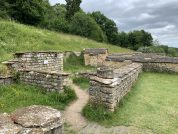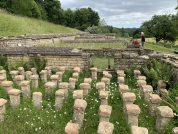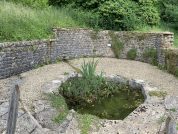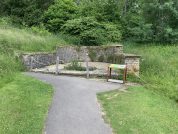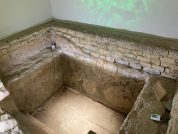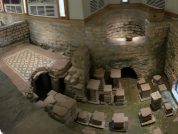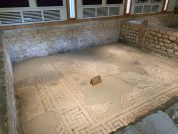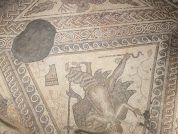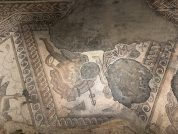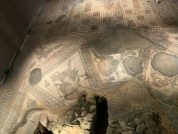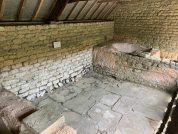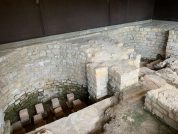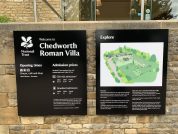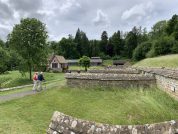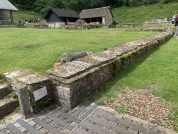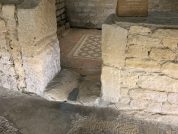Chedworth Roman Villa
Villa
Chedworth Roman Villa is located near Chedworth, Gloucestershire, England and is a scheduled monument. It wa one of the grandest Roman Villas in Britian. In its prime, in the 4th century the villa boasted two bath houses, extensive mosaics, and a water shrine. The villa continued to be inhabited into the 5th century, long after the Roman way of life was though to have stopped.
The villa was built in phases from the early 2nd century to the 5th century, with the 4th-century construction transforming the building into an elite dwelling arranged around three sides of a courtyard. The 4th-century building included a heated and furnished west wing containing a dining-room (triclinium) with a fine mosaic floor, as well as two separate bathing suites: one for damp-heat and one for dry-heat.
Historians have debated whether Chedworth was a villa rustica or a religious sanctuary and hostel, as evidence has been found in support of both arguments. Most currently believe, however, that Chedworth was the former, inhabited by a very wealthy Romano-Briton.
Discovery and Excavations at Chedworth Roman Villa
The villa was accidentally discovered in 1864 by Thomas Margetts, a gamekeeper who was digging for a ferret, and found fragments of mosaic tesserae. The site was subsequently excavated in 1865-7 by James Farrer, an antiquarian and the Member of Parliament for South Durham. The owner of the land was the Earl of Eldon, and it was he who financed the excavations, roofing for the mosaics, and the building of the mock-Tudor lodge to house the artifacts. Little, if anything, of the excavations was recorded. Only the best four mosaics were left exposed under shelters and the rest were reburied for their protection.
In 1924 the villa was acquired by the National Trust. Excavations have taken place periodically since then.
In 1957-1965 Prof. Ian Richmond excavated and re-interpreted Chedworth but died in 1965 without publishing any results. Parts of the villa were re-buried.
In 2011 a new cover building was provided for the mosaics in the west wing to ensure their preservation.
A geophysical survey of the field east of the villa in 2012 revealed a central approach road running up from the valley floor and two other buildings, one a circular stone structure on the south side of the road.
A new excavation campaign started in 2013 on the north wing and has revealed previously unrecorded mosaics, partially destroyed by Ian Richmond in 1964.
Where is Chedworth Roman Villa situated
The villa stands in a sheltered, shady, position overlooking the River Coln in the Cotswold Hills in Gloucestershire. It was located just off the Roman road known as the Fosse Way, and 8 mi (13 km) north of the important town of Corinium Dobunnorum (Cirencester). Cirencester’s reputation as a centre of tribal government and a civitas capital led to quick romanisation of the area and resulting concentration of wealth. Chedworth’s location in the Cotswolds and the valley of the River Coln was important for agriculture. It was one of about fifty villas in the Cotswolds, and one of nine in just a 5 mi (8.0 km) radius.
The villa was deliberately located next to a natural spring in the north west corner of the complex which was the villa’s main source of water, and around which was later built an apsidal shrine to the water-nymphs (nymphaeum).
History of Chedworth Roman Villa
Chedworth Roman Villa in the Iron Age
The earliest evidence of a settlement on the site of the Roman villa is of the Iron Age period. Barrows in the locality date from that period. August 2001 revealed an infant burial which was scientifically dated to be from 360 BC. It is unlikely that the barrows would have been built in dense woodland and so it is probably that the landscape was more open that now. Environmental evidence also suggests that the climate was wetter.
August 2001 revealed an infant burial which was scientifically dated to be from 360 BC. This suggests that an Iron Age settlement of unknown size may have been on this site during that period of time.
It is possible that the Roman Villa was preceded by an Iron Age house located in the lower courtyard area. The earliest evidence of the villa is a rough trackway in the lower courtyard and some post holes. This area was probably initially a farmyard with outbuildings.
The initial construction was related to the retirement of veteran soldiers as the area became settled under Roman rule. The two nearest settlements were Corinium (Cirencester) founded in about 50 and Glevum (Gloucester) founded in 97. When these centres ceased to be military bases, the soldiers retired to lands provided by the Roman governorship in recognition of military service. It is noteworthy that twenty-two Roman villas have been found within a ten-mile radius of Chedworth.
Chedworth Roman Villa in the Second Century AD
The villa has gone through several stages of growth and rebuilding. In order for the villa to be built the valley floor required terracing and soil was dug from the slopes and placed downhill to create a series of platforms.
The villa was founded about 120 and during this earliest phase (Phase I) the villa consisted of separate buildings around 3 sides of a rectangle open to the east with a bath house to the north. The original structures were quite utilitarian in nature unlike the later grandeur of the estate. Archaeologists have identified at least six different periods of construction or re-construction. All of these stages resulted in an expansion or an improvement of the original buildings.
Chedworth Roman Villa in the Third Century AD
In the early 3rd century (Phase II) the west and south wings were rebuilt following a fire, and the north bath suite was enlarged with extra rooms added to its eastern side.
Chedworth Roman Villa in the Forth Century AD
In the early 4th century (Phase III), the villa was transformed into an elite dwelling enclosing the courtyard. The existing wings were linked by a covered portico, and an inner garden and outer courtyard were created. The dining-room (triclinium) received its mosaics and the northern half of the west wing was converted to become a second set of baths. Shortly afterwards (Phase IIIA) the baths in the north wing were rebuilt and changed to dry-heat (laconicum) baths, which meant that the villa had both damp-heat and dry-heat bathing suites. The floors of at least 15 rooms were decorated with mosaics. In the late 4th century (Phase IV) the north wing was extended with the addition of a new dining-room. Many of the rooms, particularly the dining rooms were heated by hypocaust.
Chedworth Roman Villa in the 5th Century
A feature unique in Britain and discovered in 2017 is that a significant building phase of the villa dates from the 5th century after the end of Roman rule in Britain (410). In room 28 the mosaic and walls on the east and west sides were installed after 424. This is the first evidence that concentrated wealth funded Roman lifestyles in Britain for at least 50 years later than previously thought, as the building of new rooms with a mosaic is evidence of prestige spending on specialized skills including mosaic craftsmen. Other mosaics in neighbouring rooms, including room 30, show stylistic similarities and may also be of the 5th century.
Later a workshop was installed on top of the mosaic floor and two hearths, made out of pieces of architecture of the villa, were built into the worn floor of the room. 52% of the coins found at the villa date from 564 to 585 showing that intensive occupation continued into the post-Roman period.
What can you see at Chedworth Roman Villa
The Grand Dining Room (Ticlinium)
The villa’s owners would lay on lavish meals and entertain in this room. The Ticlinium takes its name from the Latin for ‘three couches’ arranged around the three sides of the room. Guests would recline and dine from tables. By the 4th century a semi-circular (stibadium) was more fashionable. From there guests could admire the mosaics in the centre of the room.
Mosaics of the Grand Dining Room (Ticlinium)
The scenes are based on the myth of Bachuus, god of wine, in an octagonal arrangement. at the corners the figures represent the four seasons. Although in good condition, there are substantial portions of it missing.
Nymphaeum at Chedworth Roman Villa
The pool in the north-west corner of the villa complex was developed from the naturally occurring fresh-water spring which most likely inspired the location of the villa in the first place. The spring became a location for an apsidal shrine to the water-nymphs (nymphaeum). The extant curved rear wall is 2 metres high and is the original Roman masonry.
All of the water needs of the villa were provided for by this spring. An octagonal pool is located at the centre and is still fed by the spring; a Christian chi-rho monogram was discovered scratched onto what was the rim of the pool. This symbol had a short presence in the early fourth century but was soon replaced by the original water nymphs.
Temples at Chedworth Roman Villa
Foundations of a Romano-British temple have been excavated about 800 metres south-east of the villa buildings. The remains comprise the southwest and southeast corners of a rectangular building, measuring 16.5m by 16.0m. Altars preserved in the villa museum probably came from the temple as did coins, glass tesserae and a stone carved niche.
A square temple lies 700 yards to the south-east of the villa beside the River Coln. The cella was recorded in 1866 but has since been robbed. The outer portico measures 51 feet by 49½ feet and has walls of excellent workmanship around 5 feet thick. The walls survive in places up to 7 feet high (including foundations). Round columns with drums 1½ ft. in diameter may have been up to 12 ft. high, and were found with bases in the outer “portico” wall. The orientation of the temple is not known. First built during the mid-2nd century, the temple remained in use until the 4th century. (Type Ia)
Other Buildings at Chedworth
There was, however, another Roman building in Chedworth Woods about 150 metres northwest of the villa which was destroyed in the construction of the railway around 1869. Finds included coins, hexagonal tiles, fragments of pillars, part of a shell-headed niche and glass tesserae. The stone relief of a “hunter god” with hare, dog and stag, sometimes ascribed to the southeast temple, may have come from this site.
Another carved figure was discovered bearing a fragmentary inscription which it is believed may refer to the healing god Mars Lenus, a deity of the Treveri tribe in Gaul.
RIB 126 - Altar dedicated to Lenus Mars
To Lenus Mars.
For Lenus Mars see RIB 309 Mars Lenus sive Ocelus (Caerwent); AE 1915, 70 Lenus Mars et Ancamna (Trier). Haverfield EE ix 1009 shows how the god was intimately connected with the Treveri. Baddeley interprets the figure as a war-god with spear and axe. Heichelheim, quoted by Mrs. Clifford, regards it as Sucellus, but gives no reading. Addenda from RIB+add. (1995): ‘I am doubtful whether the inscription can be read with real certainty’: Henig, CSIR i, 7. 126. See Pl. 32 ibid. Goodburn (to R.S.O.T.) agrees from autopsy; see Goodburn, The Roman villa, Chedworth (1972), Pl. 10.1.
There are three Latin inscriptions on stone recorded in the first volume of the R.I.B. for the Chedworth area; a relief of Mars Lenus (vide RIB 126 infra) a stone inscribed simply PRASI.A (RIB 127), and another stone bearing the inscription XR repeated four times. Chi-Rho in Greek, these are the first two letters of the name of Christ, or ??????? (RIB 128). The first and last of these inscriptions are associated with the Romano-British temple to the east of the Villa (at SP0613).
References for Chedworth
Temples in Roman Britain by M.J.T. Lewis (Cambridge 1966); The Roman Inscriptions of Britain by R.G. Collingwood and R.P. Wright (Oxford 1965).Temples in Roman Britain by M.J.T. Lewis (Cambridge 1966); The Roman Inscriptions of Britain by R.G. Collingwood and R.P. Wright (Oxford 1965). Temples in Roman Britain by M.J.T. Lewis (Cambridge 1966); The Roman Inscriptions of Britain by R.G. Collingwood and R.P. Wright (Oxford 1965).Temples in Roman Britain by M.J.T. Lewis (Cambridge 1966); The Roman Inscriptions of Britain by R.G. Collingwood and R.P. Wright (Oxford 1965).
Map References for Chedworth
NGRef: SP0513 OSMap: LR163
Roman Roads near Chedworth
NE (9) to Bovrton (Gloucestershire) SW (6) to Corinivm (Cirencester, Gloucestershire)
Sites near Chedworth Roman Villa
- Wycomb (7 km)
Minor Settlement - Combend Villa (7 km)
Villa - Wycombe Temple (7 km)
Temple Or Shrine - Barnsley Park Villa (8 km)
Villa - Bagendon Settlement (8 km)
Iron Age Settlement and Settlement - Daglingworth Villa (11 km)
Villa - Fosse Way (12 km)
Roman Road - Corinium Dobunnorum (Cirencester) Vicus (12 km)
Vicus - Cirencester (Corinium Dobunnorum) Roman Fort (12 km)
Neronian Auxiliary Fort (AD 54–68), Vexillation Fort and Vicus - Spoonley Wood Roman Villa (12 km)
Villa
